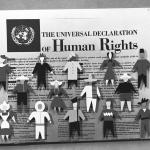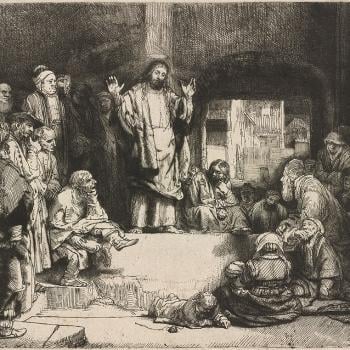
We must not confuse what we have apprehended of the truth and turned into some sort of fact, even dogmatic fact, as being the same thing as the truth in itself. It is, at best, a conventional expression of the truth. We can designate it as a conventional, or relative, truth so long as its conventional status is kept in mind and that the absolute truth itself is understood as being something other than our apprehension. When someone equivocates between conventional and absolute truth, acting as if the conventional truth were absolute, such as those who conflate human knowledge of conventional truths with the truth, despite all their claims about promoting and supporting the absolute truth, they turn away from it and create an ideology (or idol or heresy) which they try to put in the place of the truth itself.
The absolute truth transcends human comprehension; whatever we comprehend cannot be and will not be the absolute truth. Our understanding of the truth is not the truth as it is in and of itself. Our knowledge of the truth must be seen as a pointer to the truth instead of the truth itself. When we objectify some convention used to represent the truth, acting as if the convention itself was not a mere convention but the absolute truth, we cut ourselves off from the truth, and so our use of the convention differs from those who understand its limitation and how it should be used to point to the truth which lies beyond the convention itself. Those who absolutize the convention in this fashion also turns it into a kind of tribal totem to rally people around so that they can and will fight against everyone who does not want to use that convention, even if others have a different convention which points to the same truth intended by those who originally established the convention. We can see this dynamic at play in the Christological debates surrounding Chalcedon, where one group, those who denied Chalcedon, rallied around the terminology used by St. Cyril of Alexandria, who, in his own time, was willing to accept terminology which helped establish the Chalcedonian definition.
Cyril believed that Nestorius split Christ into two, that is, into a divine and human person. Cyril said Christ is fundamentally one, and dividing Christ into two persons would make Christ no longer God directly acting in the world through the incarnation, but rather, it would mean that a divine person was acting through a human person, but not truly incarnate in the world. He believed that this is something we saw with the way God worked in and through others, such as the prophets, meaning, there would be little to no difference between the man Jesus and others whom God worked through. Thus, to defend the incarnation, Cyril focused on the unity of Christ, how Christ can be and should be said to be one. Mary is the Theotokos, the Mother of God, because the one who was born of her, Jesus, was God and not just someone God entered in and associated with. The problem Cyril had in presenting the unity of Christ was that he did not have the technical vocabulary he needed to do so without confusion. That vocabulary was still being developed. In his time, the concept of nature and person was easily interchangeable, which is why, in his early work against Nestorius, he would describe the incarnation as “one incarnate nature”:
But who would be so misguided and stupid as to think that the divine nature of the Word had changed into something which formerly it was not? or that the flesh was changed by some kinds of transformation into the nature of the Word himself? This is impossible. We say there is one Son, and that he has one nature even when he is considered as having assumed flesh endowed with a rational soul. [1]
He admits, in his works, he was having a difficulty in describing Christ, because he affirmed both the humanity and the divinity of Christ:
Then he does not have two natures? that of God, and that of man?
A. Well, Godhead is one thing, and manhood is another thing, considered in the perspective of their respective and intrinsic beings, but in the case of Christ they came together in a mysterious and incomprehensible union without confusion or change. The manner of this union is entirely beyond conception. [2]
Cyril did not deny the humanity of Christ after the incarnation. He did not want anyone to think it was absorbed by the act of the assumption. However, he did not know how to describe the relationship between the two natures because of how he understood the term nature made it seem as two distinct natures would lead to two distinct persons. Others, like John of Antioch, were critical of Cyril because they saw the confusion which could and would emerge through the conventions Cyril used. John nominally supported Nestorius, though he could and would come to agree that Cyril’s intervention was justified, that Nestorius fundamentally misunderstood the nature of the incarnation. For, it is clear, Cyril and John came to understand that their main problem was not in the truth they were trying to represent, but how to find the best way to represent that truth in words. Cyril would come to accept that the unity of Christ could be preserved even if some, like John, talked about Christ having two natures. Cyril, unlike some who would come after him, was not as concerned with the terminology used to describe the incarnation as much as he was to make sure everyone intended to represent the same fundamental truth. This is why he could and would affirm the statement of union made between him and John of Antioch:
Therefore we confess that our Lord Jesus Christ, the only begotten Son of God, is perfect God and perfect man, of a rational soul and body, begotten before ages from the Father according to his divinity, and that, in recent days, he himself for us and for our salvation was born from the Virgin Mary according to his humanity, consubstantial to the Father himself according to divinity and consubstantial to us according to his humanity, for a unity was made of his two natures. We confess one Christ, one Son, one Lord. With this understanding of a union without fusion we confess that the Holy Virgin is the Mother of God, because God the Word was made flesh and was made man, and from his conception he united to himself a temple taken from her. And we know that theologians regard some of the evangelic and apostolic sayings regarding the Lord as common, that is, as pertaining to one person, and that theologians divide others of the sayings as pertaining to two natures, and refer those proper to God to the divinity of Christ, but the lowly ones to his humanity.[3]
Cyril allowed for conventions to develop, to become refined, and better. His initial hesitancy to accept talk about Jesus possessing two natures was overcome when he saw the oneness of Christ could be affirmed by those who talked about them. While the terms were still fluid, and being developed, it is clear we see the foundations for what would come out of Chalcedon. Person (or hypostasis) could be, and would be, distinguished from nature. Thus, as Grillmeier said:
So in the end the formula of the one physis-hypostasis necessarily leads to the idea of a unity of person, even if Cyril does not bring the element of person sufficiently into play, and in particular does not distinguish it either in language or concept from the concept of nature. But if we look beyond the mia-physis formula to the rest of Cyril’s language, we see that he has a series of expressions which express not only the unity of person but also the distinction of natures. From all this, then, it is clear that Cyril in fact transfers the unity in Christ into the ‘personal’ realm while ascribing a duality to the natures. [4]
Cyril’s willingness to look beyond his vocabulary, to understand its faults, to not objectify or reify it as if what was important was the word choice instead of the truth being pointed through his words, led him to reconcile with John of Antioch. Sadly, it was something many who looked up to him and his theological works would not be able to do. Those who rejected Chalcedon did so in his name. They reified his early discussion of “one incarnate nature,” despite the fact that he himself realized its weakness and should not be reified. They said Chalcedon, because it talked about two natures, denied the “one incarnate nature” of Christ affirmed by Cyril. They did not understand Cyril properly. They did not understand the unity of Christ properly. But, they could, and would say, they knew the truth because they knew the words Cyril used and continued to use them for their own Christological discussions. They took an aspect of the truth, a conventional form intended to point to the absolute truth, and reified it to create a tribal response to Chalcedon, and in doing so, needlessly split the church.
This kind of mistake consistently happens in Christian history, where conventions used in one generation are turned into absolutes by people in another, who then use such an absolutization of conventions to contend against the greater truth being promoted by the church in their age. Those conventions were not wrong, when understood to be conventions pointing to a truth which words could not contain, but can lead to error when such an apophatic caveat is ignored. Ideologies absolutize what should not be absolutized. Rote memorization of facts, facts which use human conventions to point to truths beyond conventions, easily becomes confused when people believe that they have comprehended the truth by their memorization such conventions. Truth is not something comprehended by us. Our conventions do not comprehend the truth and so should not be confused with the truth itself.
[1] St. Cyril of Alexandria, On the Unity of Christ. Trans. John Anthony McGuckin (Crestwood, NY: St Vladimir’s Seminary Press, 1995), 77.
[2] St. Cyril of Alexandria, On the Unity of Christ, 77.
[3] St. Cyril of Alexandria, Letters 1-50. Trans. John I McKenerney (Washington, DC: CUA Press, 1985), 145-6 (Letter 38 by John of Antioch to Cyril) and 149 (Letter 39 by Cyril to John of Antioch).
[4] Aloys Grillmeier, SJ, Christ in Christian Tradition: From the Apostolic Age to Chalcedon (451). Trans. J.S. Bowden (New York: Sheed and Ward), 411-12.
Stay in touch! Like A Little Bit of Nothing on Facebook.
If you liked what you read, please consider sharing it with your friends and family!
N.B.: While I read comments to moderate them, I rarely respond to them. If I don’t respond to your comment directly, don’t assume I am unthankful for it. I appreciate it. But I want readers to feel free to ask questions, and hopefully, dialogue with each other. I have shared what I wanted to say, though some responses will get a brief reply by me, or, if I find it interesting and something I can engage fully, as the foundation for another post. I have had many posts inspired or improved upon thanks to my readers.












